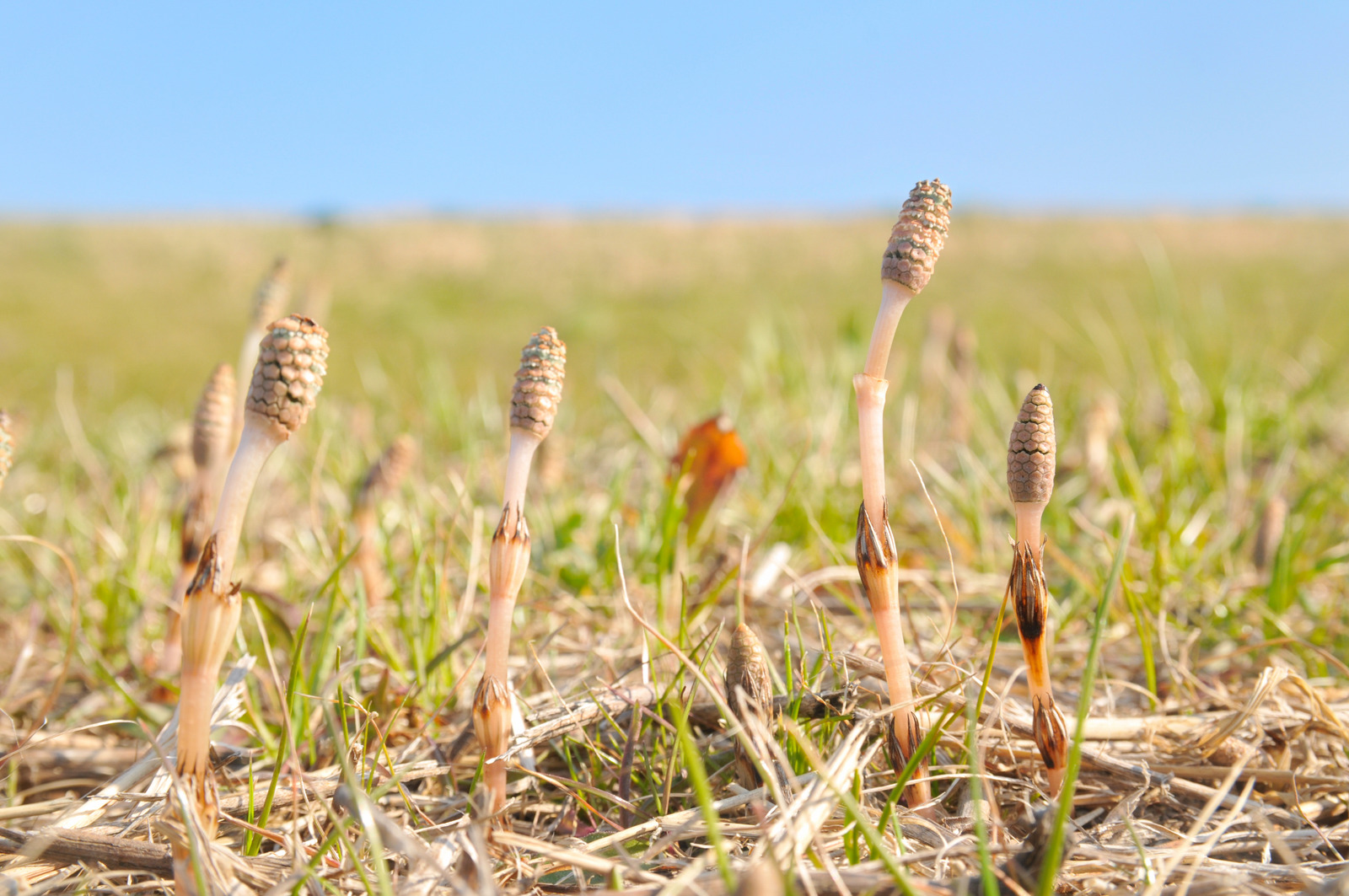
Latin: Equisetum arvense L.
English Name: Field Horsetail Leaf
Horsetail (Equisetum) is a species of plant in the horsetail family (Equisetaceae). They are perennial and herbaceous plants that grow in wet meadows and water banks. The internodes are usually hollow. The surfaces of the stems are covered with silica. Cones are terminal. Equisetum avense is a perennial herb of creeping rhizomes, often forming large colonies; roots hollow, toothed, jointed. Green stems with sterile, curving branches and nodes; leaves have become a brownish, toothed sheath around the node. Fertile stems brownish to whitish, with a large ‘cone’ of spore-producing scales at the tip; cone produced in early spring. Seeds ripen in April. Suitable for: light (sandy), medium (loamy) and heavy (clayey) soils and nutrient-poor soils. Suitable pH: slightly acidic, neutral and basic (slightly alkaline) soils. Can grow in part shade (light woodland) or without shade. Prefers dry or moist soil.
Horsetails have an unusual chemistry compared to most other plants. They are rich in silica, contain various alkaloids (including nicotine) and various minerals. Horsetail is very astringent and makes an excellent clotting agent, stops wounds, stops nosebleeds and reduces blood flow. It helps to accelerate the repair of damaged connective tissue, increase its strength and elasticity. The plant is anodyne, antihemorrhagic, antiseptic, astringent, carminative, diaphoretic, diuretic, galactogogue and haemostatic. Green stems are used, they are most active when fresh but can be harvested in late summer and dried for later use. The plant is a useful diuretic when taken internally and is used in the treatment of kidney and bladder problems, cystitis, urethritis, prostate disease and internal bleeding and has proved particularly useful when there is bleeding in the urinary tract. It is especially effective in nosebleeds. A decoction of the plant added to the bath benefits slow-healing sprains and fractures, as well as some irritating skin conditions such as eczema. The plant contains echisetic acid, which is thought to be the same as aconitic acid. This substance is a powerful heart and nerve tranquilliser and is a dangerous poison in high doses. This plant contains irritants and should only be used for short periods of time. A homeopathic remedy is made from the fresh plant. It is used in the treatment of cystitis and other complaints of the urinary system. The German Commission E Monographs, a therapeutic guide to herbal medicines, approves Equisetum arvense for urinary tract infections, kidney and bladder stones, wounds and burns.
Cosmetics: Serum, Face/body cream, Skin care
Beverage Flavour: Fruit juice, Tea, Oil
Herbal Medicine: Serum, Syrup
Extract Form: Liquid
Active ingredients: In terms of chemical composition, it contains many active ingredients such as alkaloids, flavonoids, phenol, phytosterols, saponins, sterols, silicic acid, tannins, triterpenoids and essential oils.
What Are the Ideal Growing Conditions for Field Horsetail?
Field Horsetail thrives in moist environments and is commonly found along water banks and in wet meadows. It can grow in a wide range of soil types from sandy to heavy clay, but it performs best in soils that are slightly acidic to neutral. The plant's ability to adapt to different soil conditions makes it prevalent across various climates.
Why Is Silica So Important in Field Horsetail?
Silica, a major component of Field Horsetail, plays a critical role in the plant's structure and metabolic processes. It helps to strengthen the plant’s cell walls, enhancing its rigidity and resistance to pests and diseases. In human health, silica from Field Horsetail is valued for promoting healthy skin, nails, and hair, contributing to its popularity in dietary supplements and cosmetics.
What Medicinal Properties Does Field Horsetail Have?
Field Horsetail is renowned for its diuretic, anti-inflammatory, and astringent properties. It has been used historically to treat a variety of ailments, including kidney and bladder stones, urinary tract infections, and wounds. The plant’s high content of medicinal compounds like antioxidants and minerals supports tissue repair and water balance in the body.
How Is Field Horsetail Used in Cosmetics and Skincare?
In the cosmetics industry, Field Horsetail extract is often included in formulations for skin and hair care products due to its silica content. Silica helps improve skin elasticity and hair strength. Additionally, its antioxidant properties make it a valuable ingredient in serums and creams aimed at reducing inflammation and supporting skin regeneration.
Are There Any Safety Concerns When Using Field Horsetail?
While Field Horsetail is beneficial, it must be used cautiously due to the presence of thiaminase, an enzyme that can break down thiamine (vitamin B1), potentially leading to deficiency in high doses. Therefore, it is recommended that Field Horsetail be used under the guidance of a healthcare provider, especially when consumed as a supplement over long periods.






